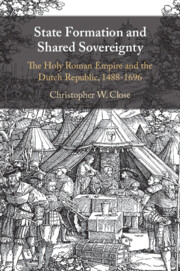Book contents
- State Formation and Shared Sovereignty
- State Formation and Shared Sovereignty
- Copyright page
- Contents
- Maps
- Acknowledgments
- Abbreviations
- Maps
- Introduction
- 1 The Swabian League and the Politics of Alliance (1488–1534)
- 2 Alliances and the Early Reformation (1526–1545)
- 3 Alliances and New Visions for the Empire and the Low Countries (1540–1556)
- 4 Shared Sovereignty and Regional Peace (1552–1567)
- 5 Shared Sovereignty and Multi-confessionality in the Empire and the Low Countries (1566–1609)
- 6 Religious Alliance and the Legacy of Past Leagues (1591–1613)
- 7 Religious Alliance and the Thirty Years’ War (1610–1632)
- 8 Westphalia and Politics of Alliance in the Empire and the Dutch Republic (1631–1696)
- Conclusion
- Bibliography
- Index
5 - Shared Sovereignty and Multi-confessionality in the Empire and the Low Countries (1566–1609)
Published online by Cambridge University Press: 02 March 2021
- State Formation and Shared Sovereignty
- State Formation and Shared Sovereignty
- Copyright page
- Contents
- Maps
- Acknowledgments
- Abbreviations
- Maps
- Introduction
- 1 The Swabian League and the Politics of Alliance (1488–1534)
- 2 Alliances and the Early Reformation (1526–1545)
- 3 Alliances and New Visions for the Empire and the Low Countries (1540–1556)
- 4 Shared Sovereignty and Regional Peace (1552–1567)
- 5 Shared Sovereignty and Multi-confessionality in the Empire and the Low Countries (1566–1609)
- 6 Religious Alliance and the Legacy of Past Leagues (1591–1613)
- 7 Religious Alliance and the Thirty Years’ War (1610–1632)
- 8 Westphalia and Politics of Alliance in the Empire and the Dutch Republic (1631–1696)
- Conclusion
- Bibliography
- Index
Summary
Chapter 5 investigates the League of Landsberg’s failed attempt to admit new Protestant and Catholic territories in the early 1570s, including the Low Countries. The League’s proposed expansion presented an opportunity to create a lasting peace in the Empire by forging new ties among competing territories. At multiple points, however, both Catholics and Protestants rejected this possibility, as neither party wished to cede primary authority in the alliance. Even as the League continued to resolve neighborly disputes, support for its exercise of shared sovereignty eroded. Related processes operated in the Low Countries during the 1570s, where civil war spawned competing alliances: the Union of Arras and the Union of Utrecht. Including members that supported a variety of religious policies, the Union of Utrecht tried to solve the problem of religious diversity by devolving authority over religion to provincial governments. Such a solution meant that much of the United Provinces’ subsequent political development depended on how different provincial authorities interpreted the meaning of the Union’s treaty of alliance. This dynamic remained at the heart of the Dutch Republic and its exercise of shared sovereignty throughout the late sixteenth and seventeenth centuries.
Keywords
- Type
- Chapter
- Information
- State Formation and Shared SovereigntyThe Holy Roman Empire and the Dutch Republic, 1488–1690, pp. 168 - 208Publisher: Cambridge University PressPrint publication year: 2021

